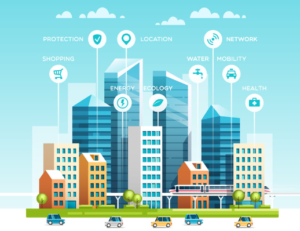
The Internet of Things (IoT) is at the heart of the development of smart cities, transforming urban environments into interconnected ecosystems that enhance quality of life, improve sustainability, and boost operational efficiency. Here’s how IoT is shaping the cities of the future:
1. Traffic Management and Smart Transportation
IoT devices are used to monitor and manage traffic flow in real time. Smart traffic lights, equipped with sensors, adjust their timing based on traffic conditions, reducing congestion and improving travel times. Additionally, connected vehicles can communicate with each other and infrastructure, providing data on road conditions, accidents, and optimal routes.
2. Public Safety and Security
IoT enhances public safety through smart surveillance systems that monitor public spaces. Connected cameras and sensors can detect unusual activities and send alerts to law enforcement. Additionally, IoT-enabled emergency response systems allow for faster coordination during crises, improving response times and resource allocation.
3. Smart Waste Management
IoT solutions optimize waste collection by using sensors in trash bins to monitor fill levels. This data allows waste management services to plan efficient collection routes, reducing operational costs and minimizing the environmental impact of waste collection.
4. Energy Efficiency and Sustainability
Smart cities leverage IoT technology to monitor and manage energy consumption. Smart grids and meters allow for real-time energy monitoring, helping residents and businesses optimize their usage. IoT solutions also enable the integration of renewable energy sources, such as solar panels, improving sustainability and reducing carbon footprints.
5. Environmental Monitoring
IoT devices play a crucial role in monitoring environmental factors such as air quality, noise levels, and water quality. This data helps city planners identify pollution sources, implement regulations, and improve public health initiatives, leading to cleaner and healthier urban environments.
6. Smart Buildings
IoT technology is used in smart buildings to enhance energy efficiency and occupant comfort. Connected systems control lighting, heating, and cooling based on occupancy and external conditions. Smart buildings can also predict maintenance needs through real-time data, reducing downtime and operational costs.
7. Citizen Engagement and Services
IoT solutions empower citizens by providing access to real-time information and services. Mobile apps can inform residents about public transport schedules, events, and local services. IoT platforms enable residents to report issues (like potholes or broken streetlights) directly to city officials, fostering community involvement.
8. Smart Parking Solutions
IoT technology simplifies parking by providing real-time information on available parking spaces. Sensors in parking lots or street spaces can communicate their status to drivers through mobile apps, reducing time spent searching for parking and decreasing congestion.
Challenges and Considerations
While the potential of IoT in smart cities is vast, several challenges need to be addressed:
- Data Privacy and Security: The collection of large amounts of data raises concerns about privacy and security. Ensuring that citizen data is protected is critical for gaining public trust.
- Interoperability: For IoT systems to be effective, different devices and platforms must be able to communicate and work together seamlessly.
- Infrastructure Investment: Developing smart city infrastructure requires significant investment and collaboration among government, private sector, and community stakeholders.
Conclusion
The integration of IoT in smart cities represents a significant shift in how urban environments are managed and experienced. By harnessing the power of connected devices, cities can become more efficient, sustainable, and responsive to the needs of their residents. The future of urban living will likely be defined by these smart technologies, paving the way for improved quality of life and a more sustainable planet.
visit: gamicaltech.com